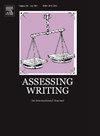Examining EFL learners’ quantity and quality of uptake of teacher corrective feedback on writing across three different editing settings
IF 5.5
1区 文学
Q1 EDUCATION & EDUCATIONAL RESEARCH
引用次数: 0
Abstract
Despite the role of dialogue in feedback uptake, no study has examined students’ uptake in different dialogue-based settings. Therefore, this study on 20 EFL Saudi students examined their uptake of feedback in self-dialogue-based, learner-learner dialogue-based, and teacher-learner dialogue-based editing settings. Analysis of teacher corrective feedback and students’ first and revised drafts of essays revealed that the rates of uptake quantity (92.3 %, 97.5 % & 95.4 %) and uptake quality (71.3 %, 80.5 % & 93.4 %) varied across the three settings, respectively. Moreover, while students integrated more global feedback in the teacher-learner dialogue (38.8 %) and learner-learner dialogue-based editing settings (38.8 %), they integrated more local feedback (69.1 %) in the self-dialogue-based editing setting. A post-hoc analysis showed significant differences in the uptake quantity in favor of learner-learner dialogue-based and teacher-learner dialogue-based editing settings and in the uptake quality in favor of the teacher-learner dialogue-based editing setting. Moreover, learner-learner and teacher-learner dialogue-based editing settings led to higher global feedback quality than self-dialogue-based setting. Students’ local feedback uptake differed significantly for the self-dialogue-based and teacher-learner dialogue-based editing settings. Despite the perceived learning benefits of feedback dialogues, students were challenged by initial apprehensions, feedback nature and technology use in feedback dialogues. The study offers useful implications for teachers and researchers.
考察英语学习者在三种不同的编辑设置下接受教师纠正反馈的数量和质量
尽管对话在反馈吸收中的作用,但没有研究考察学生在不同的基于对话的环境中的吸收情况。因此,本研究以20名沙特学生为研究对象,考察了他们在基于自我对话、基于学习者-学习者对话和基于教师-学习者对话的编辑设置中对反馈的吸收情况。通过对教师批改反馈和学生作文初稿、改稿的分析,发现学生对作文的吸收率(92.3 %,97.5 %;95.4 %)和吸收质量(71.3 %,80.5 % &;93.4 %)在三种设置中分别有所不同。此外,学生在师生对话(38.8 %)和基于学习者对话的编辑设置(38.8 %)中整合了更多的全局反馈,而在基于自我对话的编辑设置中,他们整合了更多的局部反馈(69.1 %)。事后分析显示,在学习者-学习者对话为基础的编辑设置和教师-学习者对话为基础的编辑设置的吸收数量和教师-学习者对话为基础的编辑设置的吸收质量上存在显著差异。此外,基于学习者-学习者和教师-学习者对话的编辑设置比基于自我对话的设置产生更高的全局反馈质量。在基于自我对话和基于教师-学习者对话的编辑设置中,学生对本地反馈的吸收有显著差异。尽管反馈对话对学习有好处,但学生们对反馈对话的最初理解、反馈性质和技术使用提出了挑战。这项研究为教师和研究人员提供了有益的启示。
本文章由计算机程序翻译,如有差异,请以英文原文为准。
求助全文
约1分钟内获得全文
求助全文
来源期刊

Assessing Writing
Multiple-
CiteScore
6.00
自引率
17.90%
发文量
67
期刊介绍:
Assessing Writing is a refereed international journal providing a forum for ideas, research and practice on the assessment of written language. Assessing Writing publishes articles, book reviews, conference reports, and academic exchanges concerning writing assessments of all kinds, including traditional (direct and standardised forms of) testing of writing, alternative performance assessments (such as portfolios), workplace sampling and classroom assessment. The journal focuses on all stages of the writing assessment process, including needs evaluation, assessment creation, implementation, and validation, and test development.
 求助内容:
求助内容: 应助结果提醒方式:
应助结果提醒方式:


